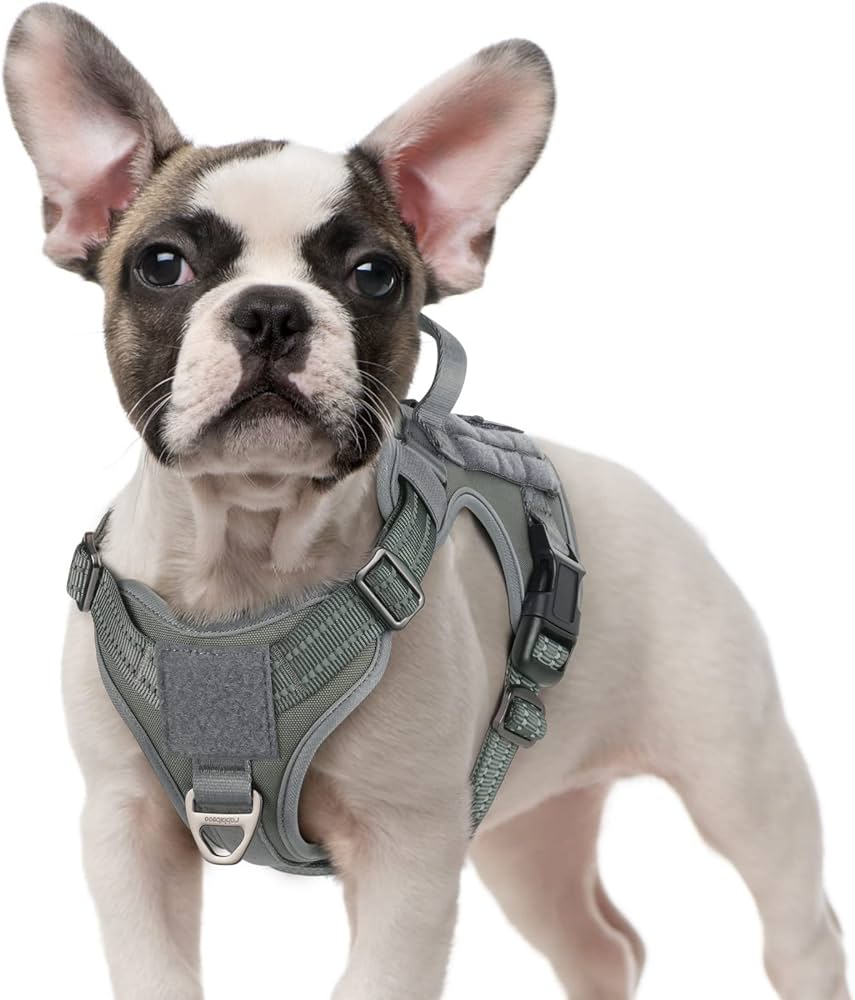Understand the importance of teaching your French Bulldog to heel for safety and control during walks.
Learn the steps to prepare for heel training, including essential supplies and preliminary obedience skills.
Discover how to introduce the heel command to your French Bulldog using hand signals and voice cues.
Find out how to use positive reinforcement effectively to reward your dog and reinforce good behavior.
Get tips on correcting common training errors and maintaining consistent practice for successful heeling.
Teaching Your French Bulldog the Heel Command
Benefits of Heel for French Bulldogs
The heel command has practical benefits:
It keeps your dog safely by your side during walks, especially important in high-traffic areas.
It prevents pulling, which can be harmful to both your dog’s neck and your arms.
It fosters a stronger bond between you and your dog through teamwork and communication.
It increases your dog’s focus and impulse control in distracting environments.
It lays the groundwork for advanced training exercises and dog sports.
Understanding Your Dog’s Learning Style
Before diving into training, it’s crucial to understand that every French Bulldog is unique. They are intelligent and can be stubborn, so finding what motivates your dog is key. Most Frenchies are food-driven, but others may prefer toys or praise. Pay attention to what gets your dog’s tail wagging, and use that as a foundation for training.
Preparation
Essential Supplies for Training
Before you start training your French Bulldog to heel, you’ll need a few supplies:
A comfortable, well-fitting harness or collar to ensure your dog’s safety.
A standard 6-foot leash that allows you to keep your dog close without restricting movement.
High-value treats that your Frenchie can’t resist.
A clicker for clicker training, if that’s the method you choose.
Preliminary Obedience Skills
Before teaching the heel command, your French Bulldog should have a grasp of basic obedience skills. These include:
Sit: To start and end the heel position.
Stay: To prevent your dog from moving ahead or lagging behind.
Look or Watch Me: To maintain focus on you during training.
Once your Frenchie has mastered these basics, you’re both ready to tackle the heel command.
Introducing the Heel Command
Breaking Down the Heel Position

Walking French Bulldogs from Huskerland Bulldogs
The heel position is when your dog walks directly by your side, matching your pace and direction. Start by choosing which side you prefer your dog to heel on, traditionally the left side. Encourage your dog to sit next to you, then reward them for staying in place.
Using Hand Signals and Voice Cues
When introducing the heel command, consistency is crucial. Decide on a specific hand signal and voice cue and stick to them. For example, you might use a sweeping hand motion toward your leg combined with the word “Heel.” Make sure to use the cue every time you want your dog to enter the heel position.
Start by getting your dog’s attention with a treat held near your leg where you want them to focus. Say “Heel,” and take a step forward. If your dog follows in the correct position, immediately reward them. If they don’t, stop, reset, and try again. Remember, short, frequent sessions are more effective than long, drawn-out ones.
Most importantly, be patient and keep training sessions positive and upbeat. Your French Bulldog will be more likely to learn if they’re having fun.
My favorite French Bulldog Training is from the K9 Training Institute.
Because they offer a professional service dog training approach to help French Bulldog owners train their dogs at home like professionals.
Join their Free Online Workshop on dog training.
Positive Reinforcement
Positive reinforcement is the most effective method for training your French Bulldog. This means rewarding behaviors you want to encourage, and ignoring or redirecting behaviors you don’t. Timing is everything in positive reinforcement. Reward your dog immediately after they perform the desired action so they make the connection between the behavior and the reward.
Choosing the Right Treats
When it comes to rewards, not all treats are created equal. For training purposes, you want treats that are:
Small enough to be eaten quickly so you can continue training without delays.
Highly palatable to your dog, something they don’t get regularly and will work hard for.
Healthy and not too calorie-dense, to avoid overfeeding.
Some French Bulldogs may have dietary restrictions, so it’s essential to choose treats that are safe for them to consume. You can also use pieces of their regular kibble, if they find it motivating enough.
Effective Reward Timing
For your Frenchie to understand what behavior you’re rewarding, you must give the treat immediately after they heel correctly. If you wait too long, they might associate the treat with something else. For example, if your dog heels and then sits, and you give the treat while they’re sitting, they may think the sit is what earned them the reward, not the heel.
Drills to Reinforce Heeling
Drills are a great way to reinforce the heel command and build muscle memory. Start with short distances in a low-distraction environment, like your living room or backyard. Gradually increase the distance as your dog gets better at staying in the heel position.
Short Heel Sessions to Build Focus
Keep training sessions short and sweet, especially in the beginning. French Bulldogs can be willful and may lose interest if sessions are too long. Aim for 5-10 minute sessions, several times a day. This keeps training fun and prevents both you and your dog from getting frustrated.
During these sessions, practice starting and stopping, and changing directions. Each time your dog successfully follows the heel command, mark the behavior with a clicker or a verbal marker like “Yes!” and reward them with a treat.
Adding Distractions Gradually
Once your French Bulldog is consistently heeling in a quiet environment, it’s time to introduce distractions. This could be training in a different room, adding in the sound of a TV or radio, or practicing in your front yard where they can see people and other dogs. Increase the level of distraction slowly to ensure your dog can succeed and stay focused on you.
Correcting Common Errors
Training isn’t always a smooth road, and you’re likely to encounter some bumps along the way. For issues like your dog not responding to the heel command, consider reviewing techniques on how to teach your dog to heel on leash to address common training challenges.
Preventing Pulling and Lagging
If your French Bulldog pulls on the leash, stop walking immediately. Stand still and wait for your dog to turn and look at you or come back to the heel position. Only resume walking when the leash is loose. If your dog lags behind, use a treat to lure them back to your side, and then reward them for catching up.
Remember, never pull your dog into position or drag them along. This can create a negative association with the heel command and damage the trust between you and your dog.
Consistency is key. If you allow your dog to pull sometimes, they won’t understand why it’s not allowed at other times. Always enforce the rule that pulling stops the walk.
Always stop walking if your dog pulls on the leash.
Use treats to lure your dog back to your side if they lag.
Never pull or drag your dog into position.
Be consistent with your rules to avoid confusion.
Maintaining Consistent Practice
Consistent practice is crucial for reinforcing the heel command. Train regularly, and don’t be tempted to skip sessions because you’re not seeing immediate results. It can take time for your French Bulldog to understand what’s expected, but with patience and regular practice, they will get there.
Also, remember to practice in different environments and at different times of day. This helps your dog understand that the heel command applies everywhere, not just in the training “zone.”
Advanced Heel Training
Once your French Bulldog has mastered the basic heel command, you can start adding more advanced elements to their training.
Begin by varying your walking speed during heel training. This teaches your dog to match their pace to yours, whether you’re walking slowly or quickly. Also, practice making turns. Start with 90-degree turns, and as your dog gets more proficient, try tighter turns and changes in direction.
Eventually, you can work on off-leash heeling in a safe, enclosed area. This is a more advanced skill and should only be attempted once your dog is reliable with heeling on a leash.
Incorporating Changes in Pace
Training your French Bulldog to heel isn’t just about walking at a steady pace; it’s about preparing them for the real world where pace can change unexpectedly. Once your pup is comfortable with heeling at a standard walking speed, start mixing it up. Slow down, speed up, and let them learn to stay by your side. It’s a fun way to keep your dog engaged and on their toes—literally!
Turning Techniques With Your Frenchie
Turning while in the heel position is another skill that will come in handy, especially on busy sidewalks or during agility training. Begin with simple turns and gradually work up to more complicated maneuvers. Always use your voice and hand signals to guide your dog, and reward them for staying close and attentive.

Frequently Asked Questions (FAQ)
How long does it take for a French Bulldog to learn to heel?
Every dog is different, but with consistent training, most French Bulldogs can learn the basics of heeling in a few weeks. Remember, the key is short, frequent training sessions and plenty of positive reinforcement. Don’t get discouraged if progress seems slow—patience is your best friend when it comes to dog training.
What if my French Bulldog is not interested in treats?
If your French Bulldog isn’t food-motivated, find another reward that does excite them. Some dogs prefer a favorite toy, a game of tug, or simply lavish praise and affection. The important thing is to find what works for your dog and use that as the incentive to follow the heel command.
For example, if your Frenchie loves playing fetch, use a quick game as a reward for a successful heel. After they’ve heeled nicely for a short walk, throw their favorite ball for a game of fetch. This not only rewards them but also reinforces the heel command as something positive and fun.
Is the heel command different for French Bulldogs than other breeds?
While the basic principles of the heel command are the same for all dogs, French Bulldogs may require a more patient and gentle approach due to their stubborn streak. Additionally, because of their brachycephalic nature, it’s important to ensure they’re not overexerting themselves, especially in hot weather.
Can older French Bulldogs learn to heel?
Absolutely! Older French Bulldogs can learn new commands, including heel. Training might take a bit longer, as older dogs can be set in their ways, but with patience and consistency, they can learn just as well as younger dogs. Remember to take into account any physical limitations due to age and to keep training sessions short to accommodate their attention span and energy levels.
How do you train a French Bulldog to heel off-leash?
Training a French Bulldog to heel off-leash is an advanced skill and should only be attempted in a safe, enclosed area. Start by reinforcing the heel command on a long lead, gradually increasing the distance between you and your dog while still maintaining control. As they become more reliable, you can transition to off-leash work, always ensuring your dog’s safety is the top priority.




Leave a Reply